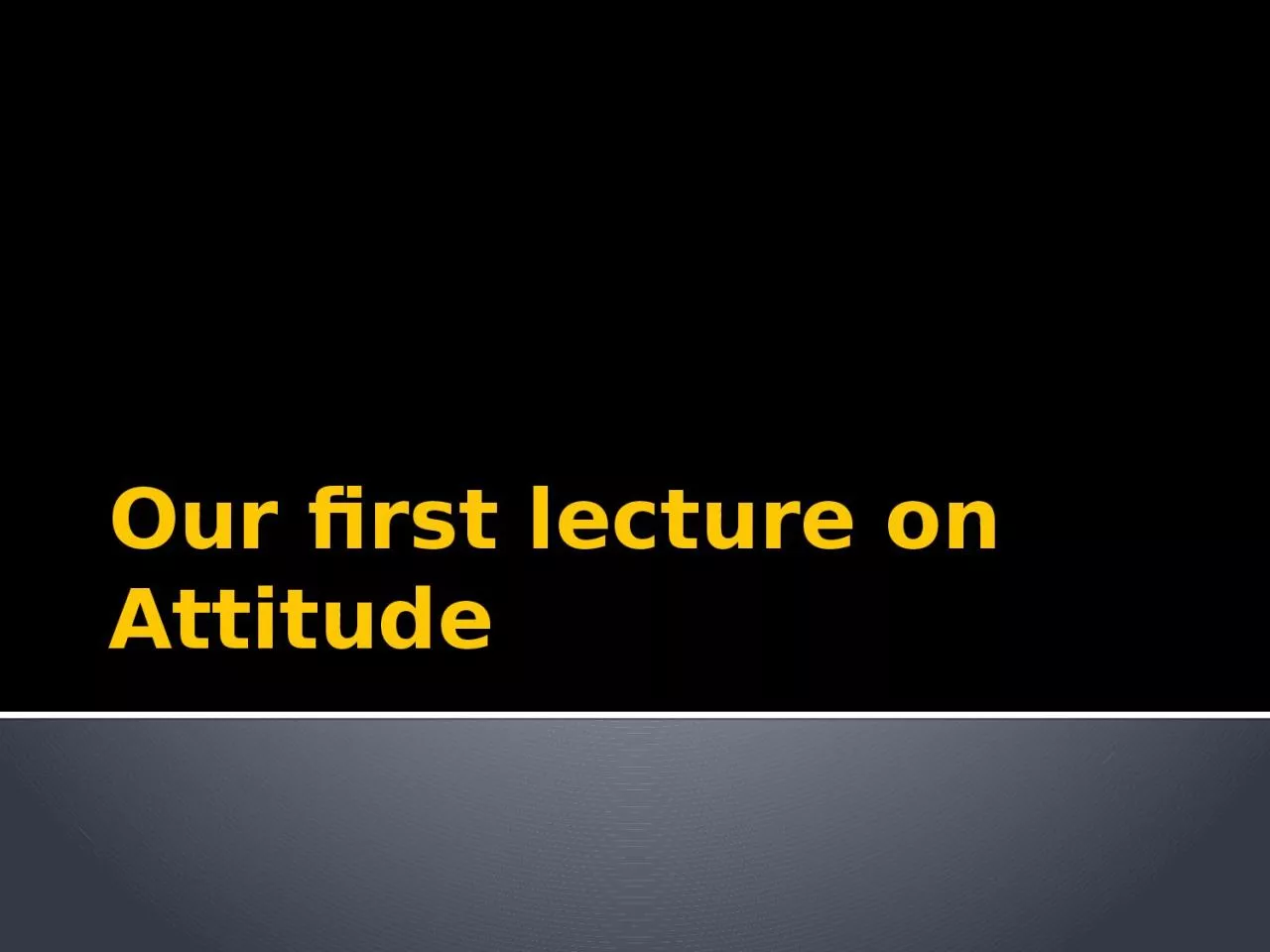

Lou Tice of the Pacific Institute Why do we choose the jobs that we do This might be a great essay question Technical ability is not enough Teamwork Coping Burnout Self worth Modeling the problem space perceptions experience prejudices loyalties preconceptions optimism ID: 1019420
Download Presentation The PPT/PDF document "Our first lecture on Attitude" is the property of its rightful owner. Permission is granted to download and print the materials on this web site for personal, non-commercial use only, and to display it on your personal computer provided you do not modify the materials and that you retain all copyright notices contained in the materials. By downloading content from our website, you accept the terms of this agreement.
1. Our first lecture on Attitude
2. … Lou Tice of the Pacific Institute
3. Why do we choose the jobs that we do?This might be a great essay question
4. Technical ability is not enoughTeamworkCoping / Burnout / Self worthModeling the problem space: perceptions, experience, prejudices, loyalties, preconceptions, optimism
5. Personality Traits and Attitude Are these good or bad?Humility vs. Self AssuranceIndependence vs. Team-centricCreative vs. DisciplinedPessimistic vs. OptimisticThese are good:Moderation in all things (especially those above)Honesty combined with diplomacyResponsibilityPersonal Hygiene
6. So let’s look at some personality traits & attitudes:Eclecticism vs. DogmaFlexibilityBeing Comfortable with Uncertainty & Errors
7. EclecticismPronunciation: e-'klek-tik1 : selecting what appears to be best in various doctrines, methods, or styles2 : composed of elements drawn from various sources;
8. DogmaPronunciation: 'dog-m&, 'däg-1 : something held as an established opinion; especially : a definite authoritative tenet 2 : a code of such tenets <pedagogical dogma> 3 : a point of view or tenet put forth as authoritative without adequate grounds
9. get a sense of perspectiveGo-to’s, pointers, and issues of clarity Go-tos are not to be “avoided at all costs”. It is, instead, serpentine code that needs to be avoided. Simplicity and clarity should override most other design decisions. A go-to, in particular, is a powerful tool when used as a direct, no-nonsense jump under well-stated conditions, and can very closely follow problem-space behavior if used with some planning and forethought. Most languages include a go-to keyword. ... published coding standards
10. Emotional WarsCoding Standards Bracket PlacementVariable Names / Naming ConventionsIndentationOO vs. non-OO (you can, but should you?)Differences between what you can do and what you should do (multi-platform? configurability? mobile site vs. app?) Design Patterns vs. DesignDocumentation Standards
11. Coding Standardshttps://users.ece.cmu.edu/~eno/coding/CppCodingStandard.html
12. The Emotional Topic of Coding StandardsPlease be patient with these coding standards until they become natural... it is only then that an honest opinion as to correctness or utility can be formed. They need not impede the feeling of craftsmanship that comes with writing software. Consider the common good. Embrace the decisions of the group. A Limited Lifetime WarrantyThe spirit of this document, not it’s rules, should dictate the place of standards and consistency within and across projects.I Never Learned This in School… Is This a Joke?You have to use some style, why not be consistent across the project?Individual styles are not best just because they’re individual.Individual styles are learned in a non-business environment (school?).Any style becomes natural after 100,000 lines.Syntax-based editors can be configured to do the mundane tasksA Real Coding Standards Defense
13. OO, Java, Design Patterns, XPObject Oriented Java supplemented by Design Patterns in an Extreme Programming methodology is currently thought to be the quickest way to develop high quality code, on a large scale, in a team and business environment. It represents the greatest advances in computer language use since high level languages were invented. However:
14. Sometimes you can’t:
15. Applications where you have to be flexible and adaptLegacy Systems – 80%-90% of all SW work Digital Signal Processing Mobile Devices – phones, mp3, etcVendor-native (Windows Mobile, PalmOS, VxWorks)GamesDatabases - SQLIndustrial Control – PLCs - Embedded Devices – auto computers, etc.
16. Learn…Visual Basic / Delphi / LabView"visual" languagesCASP.NetSQLPython, PHP, Ruby, anything....the ability to learn new languages and environments
17. Be Comfortable With UncertaintyWe were reminded that software engineering was not about right and wrong but only better and worse, solutions that solved some problems while ignoring or exacerbating others. That the machine that all the world seems to see as possessing some supreme power and intelligence was indeed intelligent, but only as we humans are: full of hedge and error, brilliance and backtrack and compromise. Ellen Ullman
18. your resumeSkills: software development, requirements specification, incremental methods, software project management, testing.Programming experience: Java, C++, Visual Basic, many more. Most structured, object oriented, and visual languages. Event- and error-driven programming. Embedded systems.
19. QuotesWriting the first 90 percent of a computer program takes 90 percent of the time. The remaining ten percent also takes 90 percent of the time and the final touches also take 90 percent of the time. ~N.J. Rubenking
20. The problem with the Dream CurveHistorically, we have relied mostly on the waterfall method: building large systems in a single large effort, throwing the switch, and hoping that all of the interactions, data boundaries, time slices, and pointers to memory work as planned. This "big bang" approach to design and implementation depends on knowing and building everything up front. Even with careful analysis and documentation, this is rarely how complex systems evolve... a design team's understanding of the problem naturally gets better through fielding and evaluation of better and better attempts. Otherwise, the concept of software versions might never be needed.
21. ScheduleDream Curve:Integration Thread:
22. The reading listReading assignment for my travel weeks October 10, 12, 17, 19. Of course my sincere apologies for being away.Essay on Objects and ModelingEssay on Levels of Thought The Integration Thread IdeaThe Tao of PoohAlogorithms Are Great But They Ruin Lives: WIREDDrop And Code Me TwentyThe Critical Thinking InstituteYou're Not Going To Need ItBig Design Up FrontThe Future Of Interactive DesignManaging Feature Creep